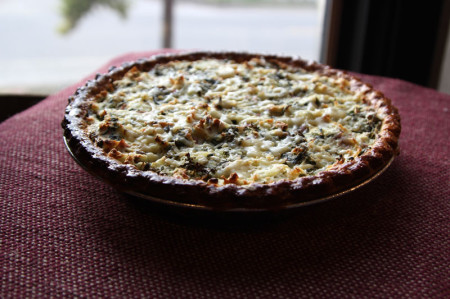
I’m having wild greens and potato pie for breakfast again, as I have for the last two mornings. You wouldn’t think greens mixed into mashed potatoes in a pie crust would be all that exciting, but I am definitely smitten.
The inspiration came from Ellen Zachos’ book, Backyard Foraging (2013), which I spent two hours walking around the neighborhood reading the other afternoon. It’s an easy read with lots of nice, clear pictures—great for gardeners with a penchant for ornamentals, because it includes edibility information for landscaping plants like hosta, spiderwort, bishop’s weed or goutweed, and mountain ash among others, unlike many foraging books that center only on weeds and/or native species.
Zachos writes how her yiayia (her grandmother) grew up in the mountains of central Greece, where wild edibles were an important part of village diets. Specifically, she recommends trying the leaves of the aggressive landscaping plant, bishop’s weed (Aegopodium podagraria), as a filling choice for Greek “pita,” or pie. Her recipe for hortopita, a less well-known cousin to spanakopita, involves an ensemble of phyllo dough, wild greens to replace the spinach, feta cheese, cottage cheese or Greek yoghurt, and eggs. It sounds absolutely divine.
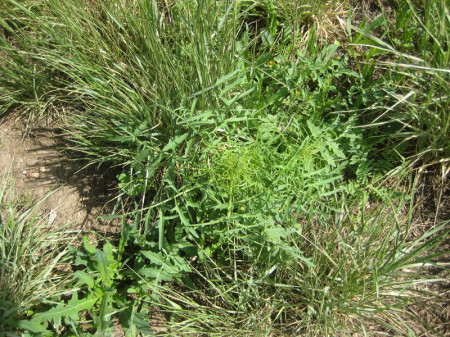
But, I didn’t have any phyllo dough or feta on hand. I did have a stack of frozen pie crusts I picked up on sale at the grocery store the other day, and some organic red potatoes. So instead I styled my wild greens pie after a recipe from Seasons Best Eats, which was in turn inspired by Irish baked pies.
The homemade crust in that recipe looks far superior to my pre-made one, but I was too tired to bother after all that hard work of foraging (!), so I went an easier route. I followed most of the steps in the recipe with some kitchen help from Gregg, boiling cubed potatoes and mashing them down with milk, Parmesan cheese, salt and pepper, meanwhile sautéing onions and dried wild garlic greens along with two bunches of fresh wild greens. Then I folded the greens into the potatoes, packed the pie crust, brushed the outer crust with egg, and baked at 425 degrees for 30 minutes (the recipe called for 40) until the crust started to burn. Gregg’s last minute suggestion to grate some tasty Robusto cheese on top and stick it back in the oven until it melted was a fantastic final touch.
The recipe called for two hand-sized bunches of chopped assorted greens, stems removed, such as spinach, broccoli raab, kale raab, swiss chard, and mustard greens. Here are the details on the wild greens I used, foraged around 6,000 feet in the greater Denver area in mid-May. I think the wild green forage you choose to put in your own pie is pretty wide open, however.
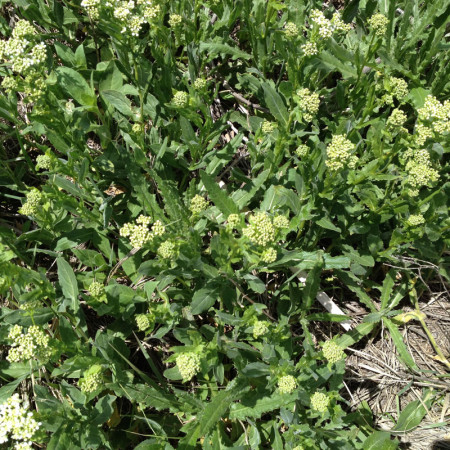
Wild Mustard Greens
Nature seems to be offering up a universe of fresh, young mustards right now, so for one of my giant hand-sized bunches, I mixed two wild-foraged mustards. First, I threw in the unopened flower buds of hoary cress or whitetop (Lepidium draba). I’ve been writing about these a lot lately, but I was happy to find another batch that had not yet gone to flower in a field behind a Fort Collins housing development, so I spent a little time harvesting them—this time being careful to minimize stem bits and leaves and mostly get the “wild broccoli.” Later, while prepping veggies for the pie, I chopped any soft stem bits and leaves I found and tossed them into the mix with the buds.
The second mustard I included was tumble mustard (Sisymbrium altissimum). I’ve been writing about this one a bit this summer too, as it’s a happy addition to my kitchen this year. We founds some flowering specimens in Fort Collins this past week too, their flowers the characteristic four-petaled form of mustards, a light lemon yellow color that I find attractive. But the plants I harvested from had not yet gone to flower. I picked entire spidery tops from plants just about to bolt or partway through the bolting process, then at home discarded the bigger, tougher stem bits, though I left plenty of crunchy leaf midribs intact on the younger rosette leaves I also gathered.
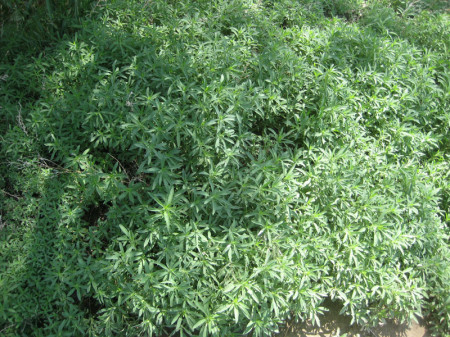
Kochia
For the other bunch of greens I used kochia. Kochia (Bassia or Kochia spp., per Seebeck, 2012), also called “burning bush,” is a Goosefoot family member, a relative of lamb’s quarters, orache, and commercially grown spinach. It is a widespread weed in Denver, and often likes to cohabitate with prairie dogs. Here I found it in an ideal situation—not a dusty prairie dog town, but growing fresh by other plants. Although I did find a patch of kochia the same day that had been sprayed with herbicides, this one was robust and lovely and seemingly untouched.
This is only my second or third time eating this plant. There are not a lot of accounts of it in the wild edible literature. Cattail Bob Seebeck writes that kochia speces are edible in his Survival Plants textbook (2012). He describes the early rosettes as having “lance-shaped, softly hairy leaves” that I’ll add are grey-green in appearance. These are weedy plants, found near farms, ranches, and towns, he writes. They branch as they grow, and develop small, inconspicuous flower heads and seeds. The most common species in our region is Kochia scoparia (syn. Bassia scoparia), he writes.
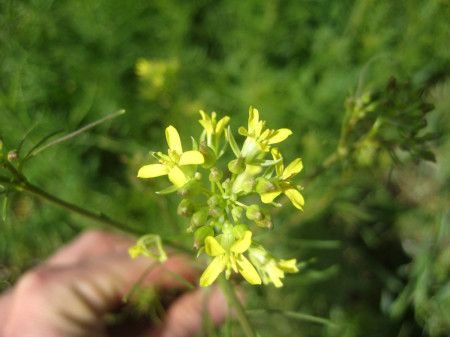
At Eat the Weeds, Green Deane cautions not to confuse Bassia scoparia, which in its mature form usually branches from the base, with fivehook Bassia (Bassia hyssopifolia), and responds to a reader’s query: “I have no reference that Bassia hyssopifolia is edible.”
However, Seebeck’s account seems to include all the species of Bassia and Kochia as edible, and his photo shows a mature plant branching from the stem, not the base.
Whichever Bassia mine turns out to be, I’ve eaten it a couple times now observing no ill effect, though clearly more investigation is merited. Some accounts warn that the plants contain saponins, which are foaming, plant-based soap-like compounds that are toxic in large quantities if you’re grazing the field like a cow, but may do some good as part of a normal, diverse diet. If you’re worried, know that spinach contains saponins too.
Alan and Sue McPerson include Kochia scoparia in their 1979 account of edible and useful wild plants in the Denver area, along with recipes for kochia stroganoff and baked kochia and almond casserole. The greens are “very good-tasting,” they write, noting that “It has spread in such numbers that few places in Denver are without it.”
I find the greens rather fuzzy and not awesome in and of themselves, but for the pie I was looking to balance the pungent mustard flavors. I was thinking bulk, workhorse greens like spinach would do the trick, so that’s why I went with the kochia. Cooked down and intermingled with flavorful mashed potatoes, I didn’t mind it at all.
Frankly I’m having trouble holding myself back from gobbling down the entire pie in one sitting.

NOTE: Whitetop or hoary cress is a pernicious invasive species that takes over gardens and fields. Thus it is a good idea not to spread seeds to new locations. Collect buds before they open. Dispose of flowering parts in a thick garbage bag rather than on the mulch pile. Clean shoes/pants of seeds after walking through a patch before journeying to the next location. But otherwise, feel free to eat this invasive without fear of harming populations. Also, at least one, albeit somewhat dubious, concern has been expressed about the plant’s edibility. See Whitetop–a Wild Invasive Substitute for Broccoli for that discussion. Aside from a field taste test and a handful of flowers here and there, I have to date only consumed whitetop in any quantity cooked.

I think the other nice thing about kochia is that it’s season is slightly later than some of the other mild greens. I like how you overcame the fuzziness. I know a lot of people are turned off by fuzzy greens. You’ve got me wanting to make savory pies now!